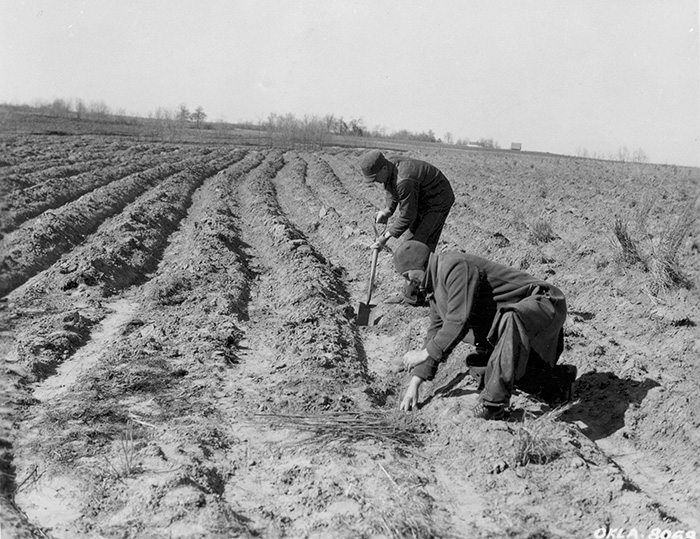SHELTERBELTS.
In response to the devastating droughts of the 1930s, on July 21, 1934, Pres. Franklin D. Roosevelt instructed the U.S. Forest Service to initiate the Prairie States Forestry Project. The project's mandate was to plant shelterbelts in six Great Plains states to protect crops and wildlife from wind, intercept blowing snow and sand, and provide wood products. Roosevelt secured the funds by executive order through the Works Progress Administration (WPA). The Forest Service located the project headquarters in Lincoln, Nebraska. Oklahoma City was the project headquarters for Oklahoma, with district offices in Elk City, El Reno, Mangum, and Enid. The original project counties were Beckham, Custer, Dewey, Ellis, Greer, Harmon, Harper, Jackson, Major, Roger Mills, Washita, Woods, and Woodward, but by 1939 the project added Beaver, Blaine, Caddo, Canadian, Comanche, Garfield, Kay, Kingfisher, and Noble. On March 18, 1935, the program's first shelterbelt was planted on the H. E. Curtis farm near Mangum.
Each project was a cooperative venture between the farmer and the federal government. Farmers desiring a shelterbelt made application, after which sites were evaluated for suitability. If admitted to the program, the cooperating farmer agreed to furnish land and fencing material, prepare the site for planting, cultivate the trees, and control rodents. Cultivation reduced competition from weeds and grasses until the trees were able to shade them out. The federal government used WPA crews to build fences, plant trees, and provide technical advice and materials for rodent control.
Shelterbelts varied in length and ranged from 100 to 165 feet wide. Rows were planted ten feet apart, with tall trees in the center rows, flanked by rows of short trees along the sides, and shrubs in the outside rows. Black locust, catalpa, Chinese elm, cottonwood, green ash, hackberry, honey locust, mulberry, Osage orange, pecan, plum, Russian olive, red cedar, and walnut were commonly planted. Maximum protection was afforded when trees reached twelve to twenty feet in height.
Some shelterbelts failed and were subsequently plowed up by farmers. Failure resulted from drought, grasshopper infestations, and improper cultivation. In 1935 tree survival was 71.5 percent and in 1936, 73.5 percent. When maintenance was turned over to farmers in 1937, survival rates dropped to 62 percent and to 61.3 percent in the following year. By the time the project closed on June 30, 1942, 145 million trees had been planted in 18,600 miles of shelterbelts in a one-hundred-mile-wide zone from Canada to the Brazos River.
See Also
CLIMATE, DROUGHT, DUST BOWL, FARMING, FLORA, ENVIRONMENT AND CULTURAL ECOLOGY, NEW DEAL, SOIL AND WATER CONSERVATION, WORKS PROGRESS ADMINISTRATION
Bibliography
Tom Croker, The Great Plains Shelterbelt (N.p.: Artistic Printers, 1991).
Daily Oklahoman (Oklahoma City), 11 June 1939.
Wilmon H. Droze, Trees, Prairies, and People: A History of Tree Planting in the Plains States (Denton: Texas Women's University, 1977).
James B. Lang, "The Shelterbelt Project in the Southern Great Plains, 1934–1970: A Geographic Appraisal" (M.A. thesis, University of Oklahoma, 1970).
Citation
The following (as per The Chicago Manual of Style, 17th edition) is the preferred citation for articles:
Bruce Hoagland, “Shelterbelts,” The Encyclopedia of Oklahoma History and Culture, https://www.okhistory.org/publications/enc/entry?entry=SH022.
Published January 15, 2010
© Oklahoma Historical Society


